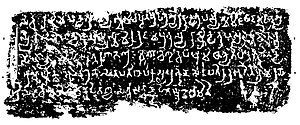Rudrasimha I
| Rudrasimha I | |
|---|---|
Western Satrap | |
 Coin of the Western Kshatrapa ruler Rudrasimha I (178 to 197). Obv: Bust of Rudrasimha, with corrupted Greek legend "..OHIIOIH.." ( Indo-Greek style).Rev: Three-arched hill or Brahmi script (from 10 o'clock): Rajno Mahaksatrapasa Rudradamnaputrasa Rajna Mahaksatrapasa Rudrasihasa "King and Great Satrap Rudrasimha, son of King and Great Satrap Rudradaman".[1] | |
| Reign | 178-197 CE |
| Predecessor | Jivadaman |
| Successor | Satyadaman |
| Issue | Rudrasena I |

Rudrasimha I was a
Reign
Numismatics and Epigraphics
From the reigns of
Influence of Abhiras
During his reign, the Abhiras became increasingly important. Some of them were even serving as generals.[4] Ashvini Agrawal thinks that the Abhira king Isvardatta was a general in the service of Rudrasimha I who deposed his master in 188 A.D and ascended the throne. Ashvini Agrawal further says that Rudrasimha I soon deposed him and regained the throne in 190 A.D.[4]
Rudrasimha I is also known for an inscription in
"Hail ! On the [auspicious] fifth
Kshatrapa Lord Rudrasiha (Rudrasimha), the son of the king, the Maha-Kshatrapa Lord Rudradaman (and) son’s son of the king, the Kshatrapa Lord Jayadaman, (and) grandson’s son of the king, the Maha-Kshatrapa Lord Chashtana, the well was caused to be dug and embanked by the general (senapati) Rudrabuthi, the son of the general (senapati) Bapaka, theAbhira, at the village (grama) of Rasopadra, for the welfare and comfort of all living beings."— Epigraphia Indica XVI, p.233
The inscription refers Rudrasimha to as simply a ksatrapa, ignoring the existence of any mahaksatrapa. According to Sudhakar Chattopadhyaya, this indicates that the Abhira general was the de facto ruler of the state, though not assuming any higher title. The inscription states Abhira Rudrabhuti as the son of the general Bapaka.[11] The Abhira dynasty was probably related Abhira Rudrabhuti.[12][11]
Notes
- ^ Rapson p.92 [1]
- ^ Rapson p.92 [2]
- ^ a b Vogel, Jean Ph (1947). India antiqua. Brill Archive. p. 299.
- ^ ISBN 9788120805927.
- ^ Rapson CCVIII
- ^ Malwa through the ages, from the earliest times to 1305 A.D. by Kailash Chand Jain p.174
- ISBN 9780195099843.
- ISBN 9781317193746.
- ISBN 978-9004057258.
- ^ Thomas, F. w (1921). Epigraphia Indica Vol.16. p. 233.
- ^ ISBN 9788120829411. Retrieved 2 January 2021.
- JSTOR 44148188. Retrieved 27 December 2020.
References
- Rapson, "A Catalogue of Indian coins in the British Museum. Andhras etc..."

